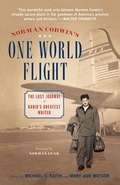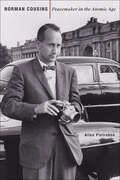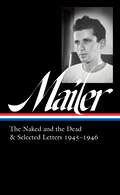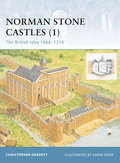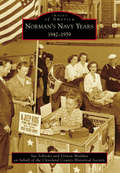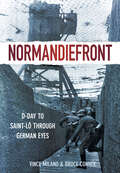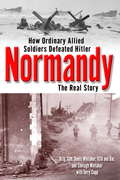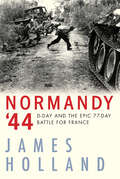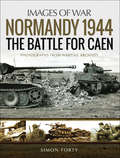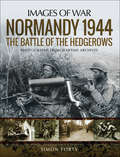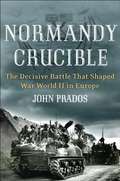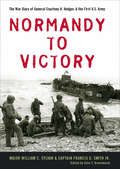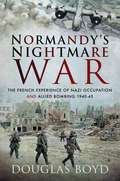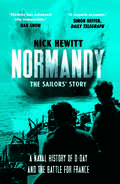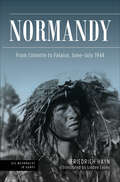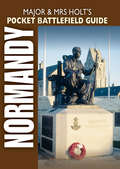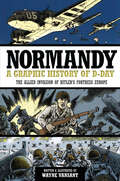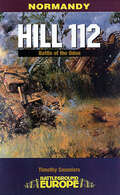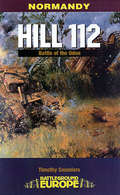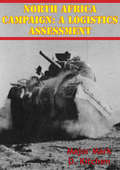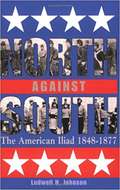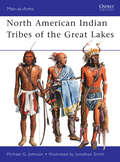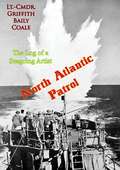- Table View
- List View
Norman Corwin's One World Flight: The Lost Journal of Radio's Greatest Writer
by Norman Corwin Michael C. Keith Mary Ann WatsonA towering figure in broadcast history, Norman Corwin has long been known as "Radio's Poet Laureate." In the late 1930s, a creative revolution was underway in the medium. What some people still called "the wireless" was maturing from a novelty into an art form. After a ten-year career as a newspaperman, columnist, and critic--which began at the age of 17--Corwin joined the ranks of aural provocateurs such as Archibald MacLeish, Arch Oboler, and Orson Welles.
Norman Cousins: Peacemaker in the Atomic Age (Johns Hopkins Nuclear History and Contemporary Affairs)
by Allen PietrobonAs the editor of the Saturday Review for more than thirty years, Norman Cousins had a powerful platform from which to help shape American public debate during the height of the Cold War. Under Cousins's leadership, the magazine was considered one of the most influential in the literary world. Cousins's progressive, nonpartisan editorials in the Review earned him the respect of the public and US government officials. But his deep impact on postwar international humanitarian aid, anti-nuclear advocacy, and Cold War diplomacy has been largely unexplored. In this book, Allen Pietrobon presents the first true biography of Norman Cousins. Cousins was much more important than we realize: he was involved in several secret citizen diplomacy missions during the height of the Cold War and, acting as a private citizen, played a major role in getting the Limited Test Ban Treaty signed. He also wrote JFK's famous 1963 American University commencement speech ("not merely peace in our time but peace for all time"). This book is a fascinating look at the outsized impact that one individual had on the course of American public debate, international humanitarianism, and the Cold War itself. This biography of the vocal anti-communist and anti-nuclear activist's public life will interest readers across the ideological spectrum.
Norman Mailer: The Naked and the Dead & Selected Letters 1945-1946 (LOA #364)
by Norman MailerA landmark in the modern literature of war by a still-controversial literary iconIncludes a selection of letters—nine never before published—that reveal the real life roots of one of the greatest American debut novels of the last centuryNearly universally praised upon publication as an achievement inviting comparison with Tolstoy and Hemingway, Norman Mailer's The Naked and the Dead is not just a monumental war novel but also a devastating antiwar novel, exposing the primal nature of power through the interplay of a platoon of soldiers on an impossible and ultimately pointless mission on an obscure island in the Pacific during World War II. Written just after the war ended, in the early days of the emerging Cold War, the novel daringly engages with the authoritarian impulses in the American character.To celebrate and commemorate the centennial of Mailer&’s birth and the 75th anniversary of the publication of his unforgettable debut novel, this expanded collector&’s edition includes a selection of 23 letters (all but four from Mailer to his first wife, Beatrice) chosen by Mailer biographer J. Michael Lennon that reveals the keen insight and powerful ambition of a brilliant young writer grappling with the challenge of converting the weight of experience into art.
Norman Stone Castles
by Adam Hook Christopher GravettDescended from the Viking raiders who settled in Northern France under the leadership of Rollo in around 911, the Normans were amongst the most feared warriors of their time. Their territorial ambitions culminated in Duke William 1's conquest of England in 1066, but although victory at Hastings left the English crown in William's hands, Norman sovereignty remained far from established on the island. In order to consolidate his position, the new king built a series of fortifications across the country - this book covers all these developments from the early days of William I through to the fortifications of Henry II, Richard I and John.
Norman's Navy Years: 1942-1959 (Images of America)
by Cleveland County Historical Society Sue Schrems Vernon MadduxIn 1944, A.L. Simon, a sailor at the Norman Naval Air Station, illustrated a booklet, "On the Beach," about Navy life in Norman, Oklahoma. The title he chose reflected the irony of the US Navy establishing two bases in a landlocked prairie town in 1942. The initial activation of the Navy bases (from 1942 to 1945) and their reactivation (from 1952 to 1959) greatly increased the employment rate and economy in Norman, offering locals a much-needed boost after the Great Depression of the 1930s. The men who influenced the Navy to choose Norman as the location for Navy installations were T. Jack Foster, of the Norman Chamber of Commerce; Joseph Brandt, president of the University of Oklahoma; and Savoie Lottinville, director of the University of Oklahoma Press.
Normandie Triangle
by Justin ScottWorld War II has just broken out. A brilliant Nazi saboteur-- code name: the Otter, son of Abwehr director Wilhelm Canaris-- prowls America. His first masterstroke: capsizing by arson in New York harbor the 1,000-foot Normandie, the super-liner-turned-troopship that could have outrun Germany's U-boats. Naval architect Steven Gates determines to raise the Normandie, put her back into the war. The Otter determines to raise the stakes: sink the Queen Mary, 12,000 troops aboard. Method: a sequestered mini-U-boat. Result: the blocking of New York harbor to Allied ships for the duration. The odds: a thousand to one-- exactly to the Otter's liking. Gates probes the treacherous, upended labyrinth of Normandie's sunken hull, marveling at her ingenious construction, and suddenly discerning the Otter's design for disaster, not only for the Allies' war effort but for himself, as he touches off a manhunt that nearly costs him the love of the only woman who can save him.
Normandiefront: D-Day to Saint-Lo Through German Eyes
by Vince Milano Bruce ConnerIn the cold morning of June 6, 1944, thousands of German soldiers are in position from Port en Bessin eastwards past Colleville on the Normandy coast, aware that a massive invasion force is heading straight for them. According to Allied Intelligence, they shouldn’t be there. 352 infantry division would ensure the invaders would pay a massive price to take Omaha beach. There were veterans from the Russian front amongst them and they were well trained and equipped. The presence of 352 Division meant that the number of defenders was literally double the number expected – and on the best fortified of all the invasion beaches. What makes this account of the bloody struggle unique is that it is told from the German standpoint, using firsthand testimony of German combatants. There are not many of them left and these accounts have been painstakingly collected by the authors over many years.
Normandy
by Shelagh Whitaker Dennis Whitaker"It was the [allied armies'] valor, their endurance, and their ability to adapt that won the battle of Normandy and launched the liberation of Western Europe." --from Normandy: The Real StoryFor decades, it's been the conventional wisdom that "brute force" alone beat the German army at Normandy. Now a definitive new history, coauthored by a highly decorated field commander, proves otherwise. Using archival data, oral histories, and exclusive new interviews, Normandy: The Real Story takes the reader deep into the minds, hearts, and souls of the allied armies to show how--despite the shortcomings of their superiors and the inferiority of their weaponry--they destroyed two well-equipped German armies and won the war.Here is the crucial summer of 1944 as seen by both sides, from the British spy, code-named "Garbo," who successfully misled the Nazis about the time and place of the D-day landings, to the poor planning for action after the assault that forced the allies to fight for nine weeks "field to field, hedgerow to hedgerow." Here too are the questionable command decisions of Montgomery, Eisenhower, and Bradley, the insatiable ego of Patton. Yet, fighting in some of the most miserable conditions of the war, the allied soldiers used ingenuity, resilience, and raw courage to drive the enemy from France in what John Keegan describes as "the biggest disaster to hit the German army in the course of the war." Normandy is an inspiring tribute to the common fighting men of five nations who won the pivotal campaign that lead to peace and freedom.From the Trade Paperback edition.
Normandy '44: D-Day and the Epic 77-Day Battle for France
by James HollandA history of World War II’s Operation Overlord, from the campaign’s planning to its execution, as Allied forces battled to take France back from Germany.D-Day, June 6, 1944, and the seventy-six days of bitter fighting in Normandy that followed the Allied landing, have become the defining episode of World War II in the west—the object of books, films, television series, and documentaries. Yet as familiar as it is, as James Holland makes clear in his definitive history, many parts of the Overlord campaign, as it was known, are still shrouded in myth and assumed knowledge.Drawing freshly on widespread archives and on the testimonies of eye-witnesses, Holland relates the extraordinary planning that made Allied victory in France possible; indeed, the story of how hundreds of thousands of men, and mountains of materiel, were transported across the English Channel, is as dramatic a human achievement as any battlefield exploit. The brutal landings on the five beaches and subsequent battles across the plains and through the lanes and hedgerows of Normandy—a campaign that, in terms of daily casualties, was worse than any in World War I—come vividly to life in conferences where the strategic decisions of Eisenhower, Rommel, Montgomery, and other commanders were made, and through the memories of paratrooper Lieutenant Dick Winters of Easy Company, British corporal and tanker Reg Spittles, Thunderbolt pilot Archie Maltbie, German ordnance officer Hans Heinze, French resistance leader Robert Leblanc, and many others.For both sides, the challenges were enormous. The Allies confronted a disciplined German army stretched to its limit, which nonetheless caused tactics to be adjusted on the fly. Ultimately ingenuity, determination, and immense materiel strength—delivered with operational brilliance—made the difference. A stirring narrative by a pre-eminent historian, Normandy ‘44 offers important new perspective on one of history’s most dramatic military engagements and is an invaluable addition to the literature of war.Praise for Normandy ‘44An Amazon Best Book of the Month (History)An Amazon Best History Book of the Year“Detail and scope are the twin strengths of Normandy ’44. . . . Mr. Holland effectively balances human drama with the science of war as the Allies knew it.” —Jonathan W. Jordan, Wall Street Journal“A superb account of the invasions that deserves immense praise. . . . To convey the human drama of Normandy requires great knowledge and sensitivity. Holland has both in spades.” —Times (UK)
Normandy 1944: Photographs From Wartime Archives (Images of War)
by Simon FortyCaen, a D-Day objective on 6 June 1944, did not fall to the British and Canadian troops of Second Army until 6 August, by which time much of the city had been reduced to rubble. The two-month struggle was a crucial stage in the Normandy campaign and, as Simon Forty demonstrates in this photographic history, one of the most controversial.His detailed, graphic account gives the reader a fascinating insight into the opposing forces, the conditions, the terrain, the equipment and weaponry deployed and it illustrates just how intense and protracted the fighting was on the ground.The reasons for the slow Allied advance have been hotly disputed. Deficiencies in British and Canadian equipment and tactics have been blamed, as has the tenacity of the German resistance. Ultimately a sequence of Allied operations sapped the defenders strength, and it is these operations Perch, Martlet, Epsom, Windsor, Charnwood, Jupiter, Atlantic, Goodwood that feature strongly in the striking photographs that have been selected for this book.They record in the most dramatic fashion the character of the fighting and show how even the SS divisions and heavy tank battalions were eventually defeated.
Normandy 1944: The Battle Of The Hedgerows (Images Of War Ser.)
by Simon FortyJust as the Anglo-Canadian forces in the east found it difficult to advance beyond Caen after D-Day, so the US First Army laboured to advance through the Norman bocage country in the west. The lethal struggle that developed there was a defining episode in the Normandy campaign, and this photographic history is a vivid introduction to it.Through a selection of over 150 carefully chosen and meticulously captioned wartime photographs Simon Forty traces the course of the battle and gives the reader a graphic impression of the conditions, the terrain and the experience of the troops.The Germans mounted a tenacious defence. They fought from prepared positions in the high hedgerows. Each cramped field and narrow lane became a killing ground. But the Americans adapted their tactics and brought in special equipment including bulldozers and tanks with hedgerow cutters to force their way through.The losses were appalling as the Germans used snipers, mines, machineguns and artillery to great effect. Inexorably, however, and with enormous bravery, First Army solved their tactical problems, inflicted heavy casualties on the defenders and ground their way to Saint-L.
Normandy Crucible: The Decisive Battle that Shaped World War II in Europe
by John Prados<p>The Battle of Normandy began on D-Day. June 6, 1944—the day that the Allied forces launched the great crusade to free Europe from the iron grip of Nazi Germany. Tightly constricted hedgerow country and bitter German resistance held the Allied advance to a crawl—until they broke through and trapped the Nazi armies. Yet within weeks of this stunning disaster, the Germans smashed the most dangerous Allied offensive yet. <p>How was this possible? Noted author John Prados answers this vexing question with an account that reframes the Normandy breakout. Shifting between battle action and command decisions on both sides, <i>Normandy Crucible</i> lucidly illustrates how this campaign molded the climactic battle for Europe.</p>
Normandy to Victory: The War Diary of General Courtney H. Hodges & the First U.S. Army (American Warriors Series #Amws)
by Major William C. Sylvan Captain Francis G. Smith Jr.This annotated edition of General Hodges&’s WWII diary offers a unique firsthand account of the First US Army from D-Day to V-E Day: &“a fascinating book&” (Bowling Green Daily News). During World War II, General Courtney Hicks Hodges commanded the First US Army, taking part in the Allied invasion of France, the liberation of Paris, and the ultimate Allied victory in 1945. Maintained by two of Hodges's aides, Major William C. Sylvan and Captain Francis G. Smith Jr., this military journal offers a unique firsthand account of the actions, decisions, and daily activities of General Hodges and the First Army throughout the war. The diary opens on June 2, 1944, as Hodges and the First Army prepare for the Allied invasion of France. In the weeks and months that follow, the diary highlights the crucial role that Hodges's command played in the Allied operations in northwest Europe. The diary recounts the First Army's involvement in the fight for France, the Siegfried Line campaign, the Battle of the Bulge, the drive to the Roer River, and the crossing of the Rhine, following Hodges and his men through savage European combat until the German surrender in May 1945. This historically significant text has previously been available only to military historians and researchers. Retired US Army historian John T. Greenwood has now edited the text in its entirety and added a biography of General Hodges as well as extensive contextual notes. A Choice Outstanding Academic TitleWinner of the 2009 Distinguished Writing Award from the Army Historical Foundation
Normandy's Nightmare War: The French Experience of Nazi Occupation and Allied Bombing, 1940–45
by Douglas BoydFamous for Calvados apple brandy and Camembert cheese, Normandy is a green and pleasant land now dotted with thousands of British-owned second homes. Its coastline is also dotted with thousands of indestructible reinforced-concrete bunkers and gun emplacements that formed part of the Atlantic Wall of Hitler&’s Fortress Europe. Tourists passing through the ferry ports like Boulogne, Cherbourg and Dunkirk may wonder why there are so few old buildings. Few know that the demolition which preceded the extensive urban renewal of the ancient town centers was effected by British bombs during four years of hell for the people living there. Before its belated liberation three ghastly months after D-Day, the sirens in Le Havre wailed 1,060 times to warn of approaching British and American bombers. After one single Allied raid, over 3,000 dead civilians were recovered from the city&’s ruins, without counting the thousands of injured, maimed and traumatized survivors. So, whom did the Normans regard as the enemy: the German occupiers who shot a few hundred civilians or the Allied airmen who killed as many neutral citizens of northern France as died in Britain from German bombs during the whole war? Told largely in the words of French, German and Allied eyewitnesses – including the moving last letters of executed hostages – this is the story of Normandy&’s nightmare war.
Normandy: A Naval History of D-Day and the Battle for France
by Nick HewittThe first account of the Allied navies’ vital contribution to the success of the D-Day landings and the Normandy campaign The Allied liberation of Nazi-occupied Europe is one of the most widely recognised events of modern history. The assault phase, Operation Neptune, began with the D-Day landings in Normandy—one of the most complex amphibious operations in history, involving 7,000 ships and nearly 200,000 men. But despite this immense effort, the wider naval campaign has been broadly forgotten. Nick Hewitt draws on fascinating new material to describe the violent sea battle which mirrored the fighting on land, and the complex campaign at sea which enabled the Allied assault. Aboard ships ranging from frail plywood landing craft to sleek destroyers, sailors were active combatants in the operation of June 1944, and had worked tirelessly to secure the Seine Bay in the months preceding it. They fought battles against German submarines, aircraft, and warships, and maintained careful watch to keep control of the English Channel. Hewitt recounts these sailors’ stories for the first time—and shows how, without their efforts, D-Day would have failed.
Normandy: From Cotentin to Falaise, June–July 1944 (Die Wehrmacht im Kampf)
by Friedrich HaynA German perspective of D-Day, written by an Army Corps intelligence officer in Normandy when the Allies invaded, published in English for the first time. A unique perspective on the decisive early weeks of the invasion in 1944, written by a German Army Corps Intelligence officer stationed in Normandy at the time of the Allied invasion, who during the invasion was the department head for enemy messages processing (Ic) in the staff of the LXXXIV AK. It discusses in detail the events leading up to the creation of Falaise Pocket, described by the author as a &“tragic turning point of an entire front.&” It discusses in detail the conditions in the American landing section and explains how the German troops based there came to be defeated.Praise for Normandy &“Should be read by scholars working on the fighting between the Americans and Germans on the western side of the Normandy front.&” —Journal of Military History &“The interaction among German command is interesting as it scrambles to patch lines. The book covers battles over D-Day beaches, U.S. paratrooper drops, Cherbourg, hedgerows, Operations Cobra and Luttich, and Falaise Pocket formation and collapse.&” —Historical Miniatures Gaming Society &“[A] unique, informative, and inherently fascinating study . . . absolutely essential and core addition to personal, professional, community, college, and university library World War II history collections.&” —Midwest Book Review
Normandy: Normandy Landing Beaches (Major & Mrs Holt's Pocket Battlefield Guide)
by Tonie Holt Valmai HoltA compact traveler&’s guide to the French region&’s World War II historical sites, featuring planned itineraries of places to see and where to go. This guidebook covers the present-day battlefield and the actions that took place on and immediately behind the D-Day beaches, and Major and Mrs. Holt's Pocket Battlefield Guide to Normandy has been put together to take you around the area. This book is part of a new series of guides designed conveniently in a small size for those who have only limited time to visit, or who are simply interested in as an introduction to the historic battlefields, whether on the ground or from an armchair. They contain selections from the Holts&’ more detailed guide of the most popular and accessible sites plus handy tourist information, capturing the essential features of the Battles. The book contains many full color maps and photographs and detailed instructions on what to see and where to visit.
Normandy: The Allied Invasion of Hitler's Fortress Europe
by Wayne VansantNormandy depicts the planning and execution of Operation Overlord in 96 full-color pages. The initial paratrooper assault is shown, as well as the storming of the five D-Day beaches: Utah, Omaha, Gold, Juno, and Sword. But the story does not end there. Once the Allies got ashore, they had to stay ashore. The Germans made every effort to push them back into the sea. This book depicts the such key events in the Allied liberation of Europe as: 1. Construction of the Mulberry Harbors, two giant artificial harbors built in England and floated across the English Channel so that troops, vehicles, and supplies could be offloaded across the invasion beaches.2. The Capture of Cherbourg, the nearest French port, against a labyrinth of Gennan pillboxes.3. The American fight through the heavy bocage (hedgerow country) to take the vital town of Saint-Lô.4. The British-Canadian struggle for the city of Caen against the &“Hitler Youth Division,&” made up of 23,000 seventeen- and eighteen-year-old Nazi fanatics.5. The breakout of General Patton&’s Third Army and the desperate US 30th Division&’s defense of Mortaine.6. The Falaise Pocket, known as the &“Killing Ground, &” where the remnants of two German armies were trapped and bombed and shelled into submission. The slaughter was so great that 5,000 Germans were buried in one mass grave. 7. The Liberation of Paris, led by the 2nd Free French Armored Division, which had been fighting for four long years with this goal in mind.
Normandy: The Battle of the Odon (Battleground Europe)
by Tim SaundersThis WWII military history and battlefield guide examines a pivotal conflict of the Battle of Normandy—including detailed maps and illustrations. Over a month after the D-Day landings, the Allies were still confined to the Normandy peninsula. The German line was anchored by the medieval town of Caen, which the British were supposed to have occupied on D-Day. The key to capturing Caen was Hill 112, known to the Germans as Kalverienberg, or "Mount Calvary". Under pressure from Churchill, Montgomery launched a major offensive. Unfortunately, German reinforcements began arriving in the Caen area. The British now faced four SS divisions and the Tigers of the 502nd SS Heavy Panzer Regiment. An all-out Allied effort, including heavy bombers and naval bombardment, was required to secure the final victory. This volume details all the action around Hill 112, with numerous illustrations and maps complementing the lively text.
Normandy: The Battle of the Odon (Battleground Europe)
by Tim SaundersThis WWII military history and battlefield guide examines a pivotal conflict of the Battle of Normandy—including detailed maps and illustrations. Over a month after the D-Day landings, the Allies were still confined to the Normandy peninsula. The German line was anchored by the medieval town of Caen, which the British were supposed to have occupied on D-Day. The key to capturing Caen was Hill 112, known to the Germans as Kalverienberg, or "Mount Calvary". Under pressure from Churchill, Montgomery launched a major offensive. Unfortunately, German reinforcements began arriving in the Caen area. The British now faced four SS divisions and the Tigers of the 502nd SS Heavy Panzer Regiment. An all-out Allied effort, including heavy bombers and naval bombardment, was required to secure the final victory. This volume details all the action around Hill 112, with numerous illustrations and maps complementing the lively text.
North Africa Campaign: A Logistics Assessment
by Major Mark D. KitchenThis study analyzes the logistics operations of the North Africa Campaign. The thesis covers wholesale and retail level preparedness and execution of the U.S. ground force sustainment following the Allied landings in northwest Africa in November 1942. The analysis concludes with the German surrender in Tunisia in May 1943.The logistical efforts of the campaign are studied against the framework of modern Airland Battle doctrine. The functional areas of manning, fueling, arming, fixing, and transporting are assessed by the doctrinal imperatives of anticipation, integration, continuity, responsiveness, and improvisation.
North Against South: The American Iliad, 1848-1877 (3rd Edition)
by Ludwell H. JohnsonNorth Against South: The American Iliad, 1848-1877 (3rd Edition). A history of the war between the States and Reconstruction.
North American Indian Tribes of the Great Lakes
by Michael Johnson Jonathan SmithThe Great Lakes were the main arena for the fur trade in colonial North America, which drew European explorers and trappers deep into the northern USA and Canada from the 17th century onwards. The desire to control the supply of this luxury item sparked wars between Britain and France, as well as conflicts between rival tribes and the newly formed United States of America, which continued until 1840. The main tribes of the area were the Huron, Dakota, Sauk and Fox, Miami and Shawnee. All were drawn into the conflicts throughout the Great Lakes region during the French-Indian War (1754-1763), as well as the American Revolution. These conflicts culminated in Black Hawk's War of 1832, as Native American tribes attempted to resist the loss of their lands to white settlers in what is now Illinois, Iowa and Wisconsin. The defeat of these tribes forever altered the climate of the central American states. This new addition to Osprey's coverage of Native American tribes details the growth of the fur trade in the Great Lakes area, the various skirmishes, battles and wars that were fought to control this vital trade and important trade area. With specially-commissioned plates, as well as photographs of locations and/or artifacts where available, expert author Michael Johnson also details the lives and material culture - including clothing, equipment and weaponry - of the local tribes themselves before their circumstances were irrevocably altered.
North American Mustang P-51: Long Range Fighter (Profiles of Flight)
by Martin W. Bowman Dave WindleThe Mustang was born from a British WW2 specification to North American during 1940. The prototype was completed within 117 days but the RAF was not happy with the aircraft's performance and suggested replacing the V-12 Allison with the more powerful RR Merlin. The result was a superbly fast and maneuverable aircraft that had the range to escort Allied bomber forces on raids deep into occupied Europe. A total of 15,469 of the type were built and used in combat until the Korean War.This book contains the world famous color profiles created by Dave Windle of the type in different operational modes, configurations and color schemes. Martin Bowman has written detailed descriptions and photographs to create the perfect enthusiasts' reference.
North Atlantic Patrol: The Log of a Seagoing Artist
by Lt.-Cmdr. Griffith Baily CoaleEyewitness account of the sinking of the U.S.S. Reuben James in Iceland as a result of a German submarine torpedo attack on 31st October 1941, vividly described in word and picture by combat artist Griffith Baily Coale."IN THIS log of his adventures on the North Atlantic Patrol, shortly before America's entrance into the War, Griffith Baily Coale has put down, directly and simply, in words and paint, what one man saw of as difficult and essential a task as any the United States Navy has been called upon to perform. And to that job he brought an unusual combination of qualities. A mural painter by profession, an expert on ship models, a small-boat sailor by choice and avocation, he knows as much about salt water as he does about paint--and he knows a lot about them both. You can't talk to Griffith Coale for half an hour without realizing that his first love is and remains the sea--and that he has a wide and accurate knowledge of ships and sailormen, past and present."
